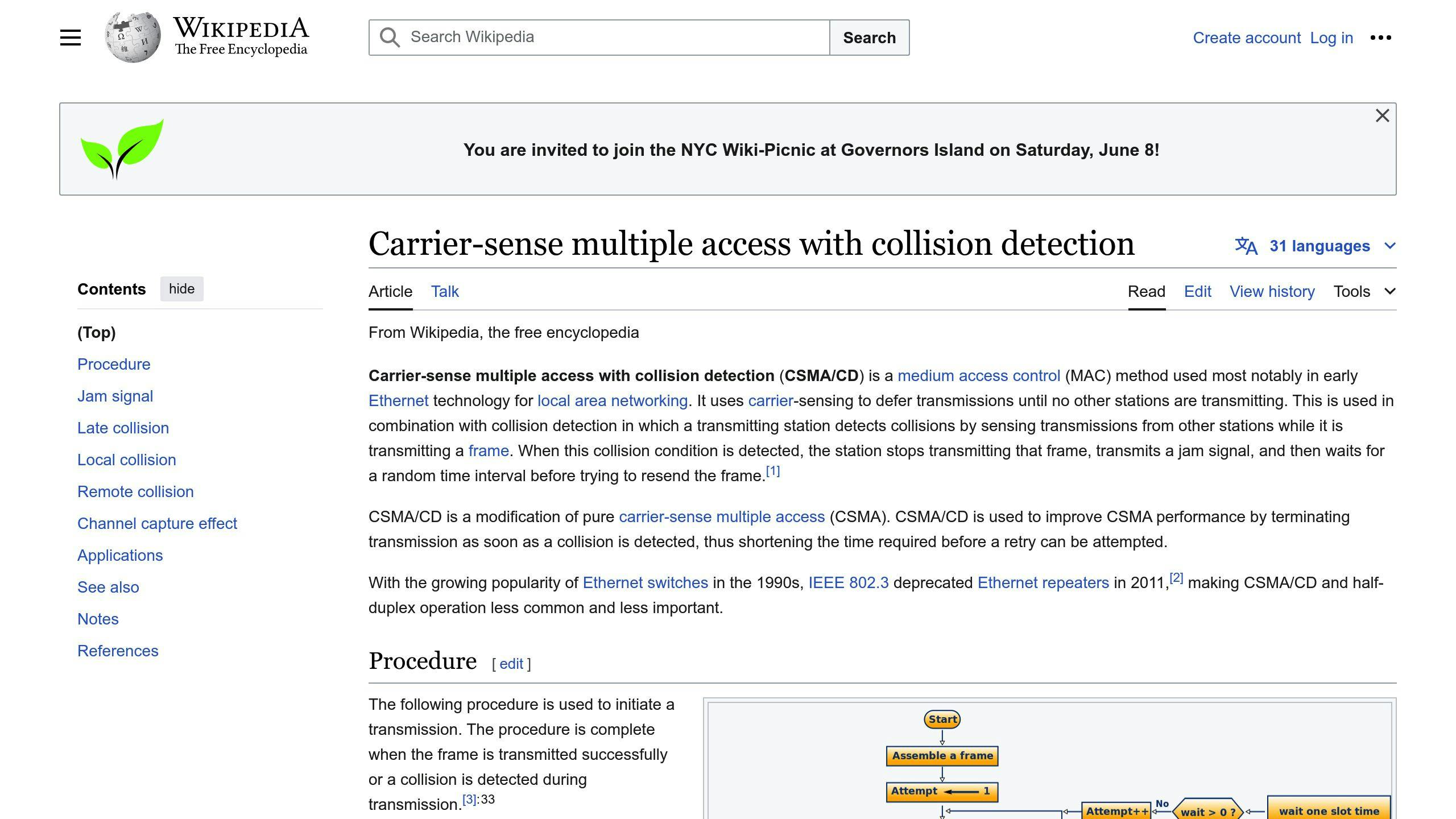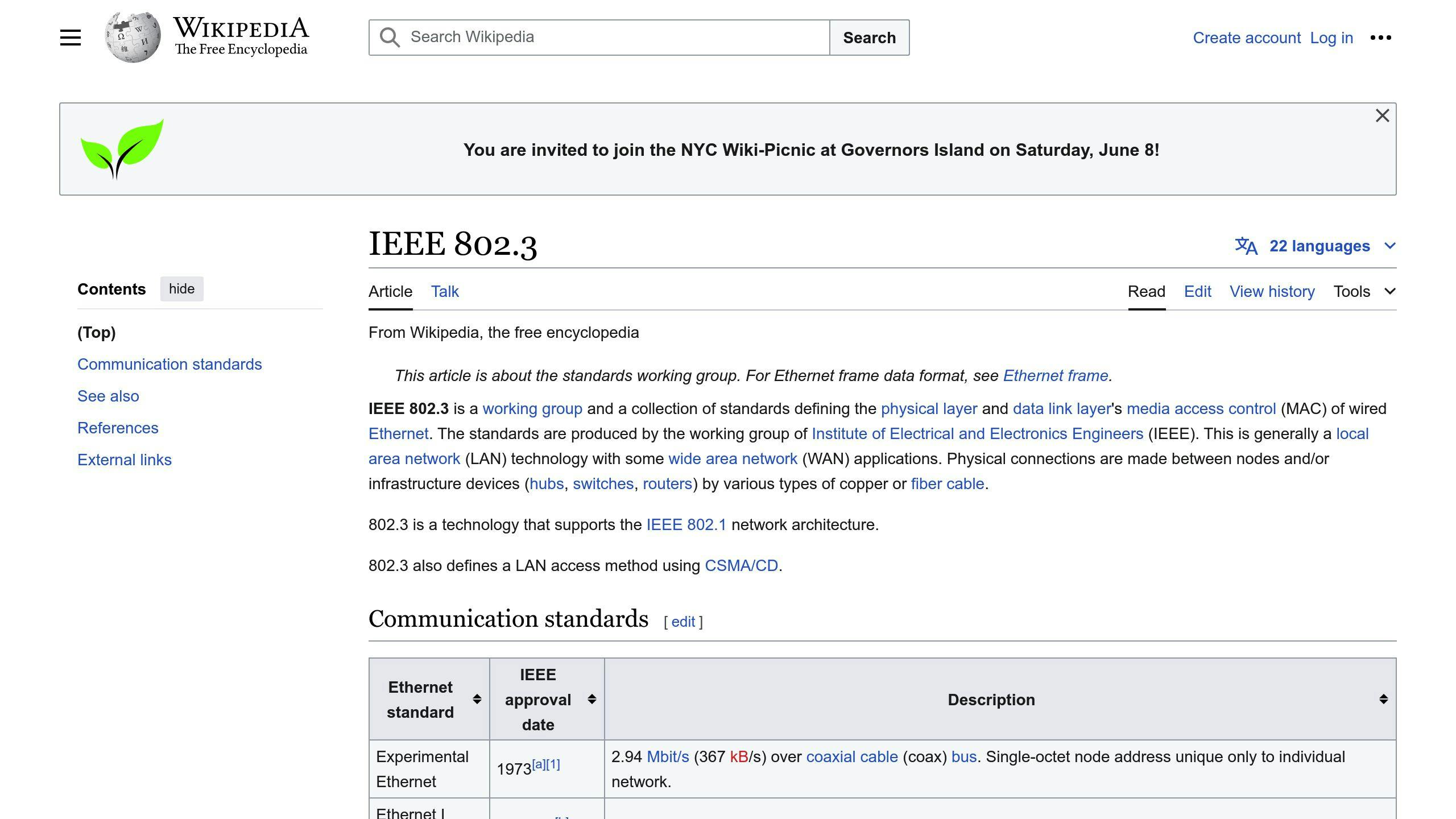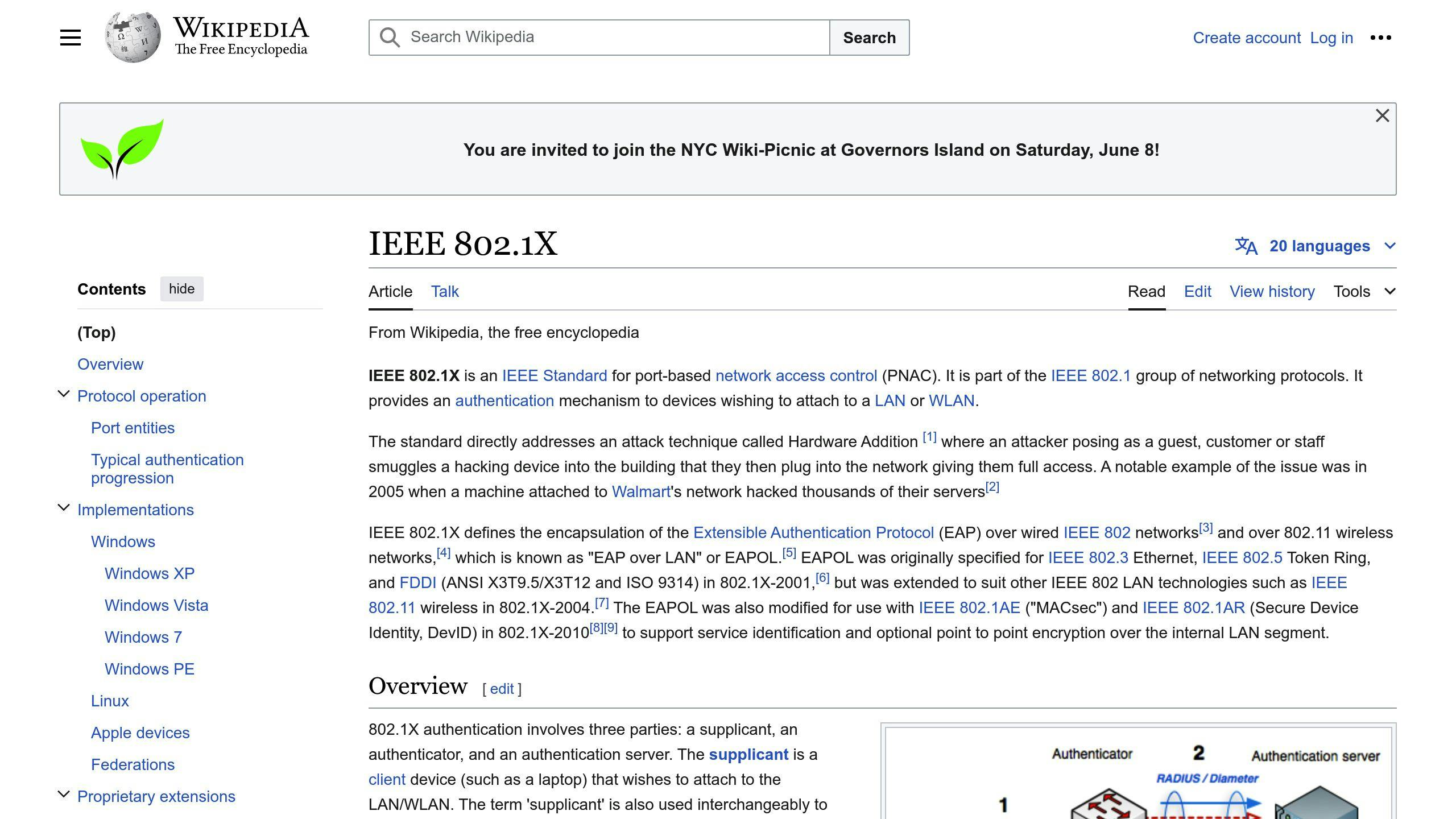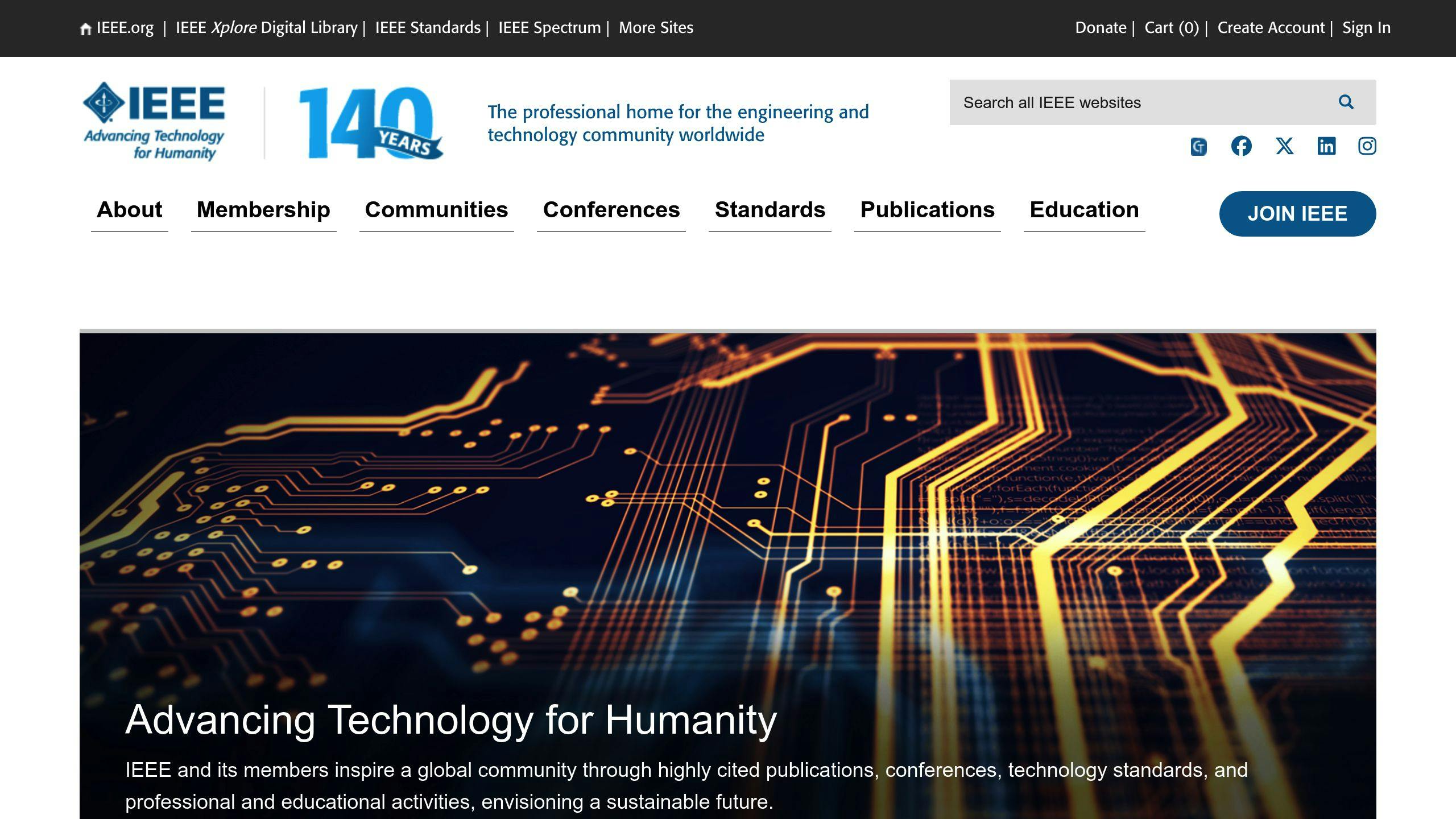Ethernet MAC (Media Access Control) standards define how devices communicate over local area networks (LANs). They ensure smooth data transfer by specifying rules for:
- Accessing the network
- Sending data frames
- Preventing collisions
Key Ethernet MAC standards include:
- IEEE 802.3: Covers physical layer (cables, speeds) and data link layer (MAC addressing, frame formatting) specifications for Ethernet LANs.
- IEEE 802.1X: Defines protocols for authenticating devices and users before granting network access.
- IEEE 802.1AE (MACsec): Provides encryption and authentication for securing Ethernet traffic.
Choosing the right standard depends on factors like:
| Factor | Considerations |
|---|---|
| Network Speed | 10 Mbps to 100 Gbps speeds available |
| Cabling Infrastructure | Copper, fiber optic, or wireless media |
| Security Needs | User authentication, data encryption, frame authentication |
| Network Type | LAN, WAN, MAN, or specific applications |
Implementing MAC standards requires compatible hardware, proper configuration, thorough testing, and performance monitoring. Common issues include incompatibility, misconfiguration, and interference.
Future trends include faster speeds up to 1.6 Tbps, new cable types like optical fiber, and applications in industries like automotive, industrial automation, and the Internet of Things (IoT).
Related video from YouTube
History of Ethernet MAC Standards

Ethernet MAC standards have a long history, starting in the 1970s. Here’s a look at how they evolved over time:
Early Ethernet
Ethernet was first developed by Robert Metcalfe and David Boggs at Xerox PARC in the 1970s. The initial version, 10BASE-5, used thick coaxial cables to connect devices. Later versions like 10BASE-2 and 10BASE-T used thinner coaxial cables and twisted-pair copper wiring.
Key Milestones
Ethernet MAC standards have seen many updates to increase speed and performance:
| Year | Standard | Speed |
|---|---|---|
| 1995 | Fast Ethernet (100BASE-TX) | 100 Mbps |
| 1999 | Gigabit Ethernet (1000BASE-T) | 1 Gbps |
| 2006 | 10-Gigabit Ethernet (10GBASE-T) | 10 Gbps |
| 2014 | 40-Gigabit Ethernet (40GBASE-T) | 40 Gbps |
| 2014 | 100-Gigabit Ethernet (100GBASE-T) | 100 Gbps |
Standards Organizations
Two key organizations have shaped Ethernet MAC standards:
1. IEEE (Institute of Electrical and Electronics Engineers)
- Develops and publishes the 802.3 standards
- Defines physical and data-link layer specifications for Ethernet
2. ISO (International Organization for Standardization)
- Provides a framework for international standards
- Ensures Ethernet MAC standards are compatible across devices and networks
Key Concepts in Ethernet MAC Standards
MAC Addressing Explained
A MAC (Media Access Control) address is a unique code assigned to each network device. It allows devices to communicate on the local network. MAC addresses are 48 bits (6 bytes) long, written as a series of hexadecimal digits, like 00:13:20:8f:3b:e7.
MAC addresses have two parts:
- Organizationally Unique Identifier (OUI): The first 24 bits identify the device manufacturer. The IEEE assigns this portion.
- Extension Identifier: The remaining 24 bits are assigned by the manufacturer to uniquely identify each device they make.
MAC addresses serve these purposes:
- Unique Identification: Each device has a globally unique MAC address for direct communication on the local network.
- Frame Addressing: MAC addresses are used as the source and destination addresses in Ethernet frames for data delivery.
- Access Control: MAC address filtering can restrict network access based on a device’s MAC address.
CSMA/CD Protocol

The Carrier Sense Multiple Access with Collision Detection (CSMA/CD) protocol controls how devices access the shared Ethernet network and transmit data. It works like this:
- Carrier Sense: Before transmitting, a device checks the Ethernet cable for any ongoing transmissions.
- Multiple Access: If no other device is transmitting, the device can start sending data over the shared network.
- Collision Detection: While transmitting, the device continually monitors the cable for any interference caused by another device transmitting simultaneously (a collision).
- Collision Handling: If a collision is detected, the device stops transmitting, sends a jam signal, and waits a random time before attempting to retransmit.
CSMA/CD ensures efficient use of the shared Ethernet network by allowing devices to transmit when the cable is free and resolving collisions through retransmission with a random wait time.
Full-Duplex vs Half-Duplex
Ethernet networks can operate in either full-duplex or half-duplex mode:
| Mode | Description |
|---|---|
| Full-Duplex | – Devices can transmit and receive data simultaneously over the Ethernet cable. – Collisions cannot occur since each device uses dedicated transmit and receive channels. – Higher throughput and efficiency compared to half-duplex mode. |
| Half-Duplex | – Devices can only transmit or receive data at a given time, not both simultaneously. – Collisions can occur when multiple devices transmit at the same time, requiring CSMA/CD for collision handling. – Lower throughput compared to full-duplex mode due to shared medium access. |
Modern Ethernet networks typically operate in full-duplex mode to maximize performance and efficiency, while older networks used half-duplex mode with CSMA/CD for collision management.
Types of Ethernet MAC Standards
Ethernet MAC standards are divided into three main categories based on speed, physical medium, and specific applications.
Speed-Based Standards
These standards specify the data transfer rates for Ethernet networks:
| Standard | Speed |
|---|---|
| 10BASE-T | 10 Mbps |
| 100BASE-TX | 100 Mbps |
| 1000BASE-T | 1 Gbps |
| 2.5GBASE-T, 5GBASE-T | 2.5 Gbps, 5 Gbps |
| 10GBASE-T | 10 Gbps |
| 25GBASE-T, 50GBASE-T | 25 Gbps, 50 Gbps |
| 100GBASE-T | 100 Gbps |
Each standard has specific requirements for cables, distances, and connectors to support the designated speed.
Media-Based Standards
These standards define the physical medium used for data transmission:
- Twisted Pair: 10BASE-T, 100BASE-TX (copper wires)
- Fiber Optic: 1000BASE-SX, 10GBASE-SR (optical fibers)
- Coaxial: 10BASE5 (coaxial cables)
- Wireless: IEEE 802.11 (radio waves)
The choice of medium depends on factors like bandwidth needs, distance, and cost.
Application-Specific Standards
These standards cater to specific industries or use cases:
- Automotive Ethernet: 100BASE-T1, 1000BASE-T1 (for vehicles)
- Industrial Ethernet: PROFINET, EtherNet/IP (for industrial automation)
- Data Center Ethernet: 25GBASE-T, 50GBASE-T (for data centers)
These standards often require additional features like reliability, security, and real-time communication.
Major Ethernet MAC Standards
Ethernet MAC standards play a key role in ensuring smooth data transfer over local area networks (LANs). Here, we’ll look at three major Ethernet MAC standards: IEEE 802.3, IEEE 802.1X, and IEEE 802.1AE (MACsec).
IEEE 802.3 Standard

The IEEE 802.3 standard defines the rules for Ethernet LANs. It covers:
- Physical Layer: Cable types, transmission speeds
- Data Link Layer: MAC addressing, frame formatting
- Network topology and architecture
IEEE 802.3 is widely used and forms the basis for many Ethernet applications like LANs, WANs, and metropolitan area networks (MANs).
IEEE 802.1X Standard

IEEE 802.1X is a standard for controlling network access. It defines a protocol for authenticating devices and users before granting network access.
IEEE 802.1X is commonly used in enterprise networks, wireless networks, and other environments where network access control is crucial. It provides:
- Improved network security
- Enhanced user authentication and authorization
- Simplified network management
IEEE 802.1AE (MACsec)

IEEE 802.1AE, or MACsec, is a standard for securing Ethernet traffic. It provides a protocol for encrypting and authenticating Ethernet frames, ensuring data transmitted over a network is protected from unauthorized access.
MACsec is useful in high-security environments like government, finance, and healthcare, where data confidentiality and integrity are essential. It offers:
- End-to-end encryption and authentication
- Protection against unauthorized access and tampering
- Compatibility with existing Ethernet infrastructure
In the next section, we’ll explore how to choose the right Ethernet MAC standard for your needs.
sbb-itb-738ac1e
Choosing the Right Ethernet MAC Standard
Selecting the appropriate Ethernet MAC standard is crucial for your network’s performance and security. Here’s a comparison of different standards and guidelines to help you make an informed choice.
Comparing MAC Standards
| Standard | Speed | Media Type | Security Features | Application Scenarios |
|---|---|---|---|---|
| IEEE 802.3 | 10 Mbps – 100 Gbps | Copper, Fiber | Collision Detection, Encryption (MACsec) | Local Area Networks (LANs), Wide Area Networks (WANs), Metropolitan Area Networks (MANs) |
| IEEE 802.1X | N/A | N/A | User Authentication, Access Control | Network Access Control |
| IEEE 802.1AE (MACsec) | N/A | N/A | Data Encryption, Frame Authentication | High-Security Environments (Government, Finance, Healthcare) |
Selection Guidelines
When choosing an Ethernet MAC standard, consider these factors:
- Network Speed: Select a standard that supports your required data transfer rate.
- Cabling Infrastructure: Choose a standard compatible with your existing copper or fiber optic cabling.
- Security Needs: Determine if you require user authentication, data encryption, or frame authentication for your network.
- Network Type: Identify the appropriate standard for your Local Area Network (LAN), Wide Area Network (WAN), or Metropolitan Area Network (MAN).
For example, if you need a high-speed LAN with robust security, the IEEE 802.3 standard with MACsec encryption would be a suitable choice. However, if network access control is your primary concern, the IEEE 802.1X standard would be more appropriate.
Implementing Ethernet MAC Standards
Putting Ethernet MAC standards into practice requires careful planning and execution. Here are some key points to keep in mind:
Best Practices
When implementing MAC standards, follow these guidelines:
- Use compatible hardware: Ensure your network devices support the chosen standard.
- Configure properly: Set up your devices and switches correctly for the desired speed and security features.
- Test thoroughly: Perform extensive testing to identify and resolve any compatibility issues.
- Monitor performance: Continuously monitor your network to optimize configurations and address potential problems.
Troubleshooting
Common issues during implementation include:
- Incompatibility: Hardware or software that doesn’t work together can cause connectivity errors.
- Misconfiguration: Incorrect device or switch settings can impact performance or security.
- Interference: Environmental factors like electromagnetic interference can affect network performance.
To troubleshoot these issues:
- Identify the problem: Determine the root cause through logging, monitoring, and analysis.
- Consult documentation: Refer to the standard’s specifications and device manuals.
- Seek expert help: If needed, consult experienced network administrators or engineers.
- Test and validate: Thoroughly test to ensure the issue is resolved.
Implementation Scenarios
Here are some common scenarios for implementing Ethernet MAC standards:
| Scenario | Recommended Standard | Considerations |
|---|---|---|
| Small Office Network | IEEE 802.3 (10/100/1000BASE-T) | – Cost-effective – Supports basic networking needs – Easy to set up and maintain |
| High-Speed LAN | IEEE 802.3 (10GBASE-T or higher) | – Supports high bandwidth requirements – Requires compatible hardware and cabling |
| Secure Network | IEEE 802.1AE (MACsec) | – Provides data encryption and authentication – Suitable for sensitive environments |
| Network Access Control | IEEE 802.1X | – Authenticates users and devices – Enhances network security |
Choose the standard that best fits your network’s speed, security, and application requirements.
Future of Ethernet MAC Standards
Faster Speeds
The need for quicker data transfer keeps growing. Applications like 4K video streaming, virtual reality, and high-performance computing require more bandwidth. To meet this demand, the IEEE 802.3 Working Group is developing new standards for higher Ethernet speeds:
- 200 Gbps
- 400 Gbps
- 1.6 Tbps
These faster speeds will enable more efficient data transfer and support the increasing bandwidth needs of modern networks.
New Cable Types
As Ethernet technology advances, new cable types are being explored for faster and more reliable data transmission:
- Optical Fiber Cables: Higher bandwidth capacity and resistance to electromagnetic interference.
- Wireless Ethernet: Provides flexibility and mobility in network deployments.
New Applications
Ethernet MAC standards are being applied in various industries:
| Industry | Application |
|---|---|
| Automotive | High-speed data transmission between sensors, cameras, and devices |
| Industrial Automation | Efficient and reliable communication between machines and devices |
| Internet of Things (IoT) | Supporting connectivity and data transmission for IoT devices |
As IoT devices become more common, Ethernet MAC standards will play a critical role in supporting their connectivity and data transmission needs.
These emerging trends and applications will continue to shape the future of Ethernet MAC standards, driving innovation and growth in the industry.
Conclusion
Key Points
In this guide, we explored Ethernet MAC standards, which enable efficient data transfer over local networks. Here are the key points:
- Ethernet MAC standards define how devices access the network, send data, and prevent collisions.
- Understanding the different types of standards, like speed-based, media-based, and application-specific, helps choose the right one for your network.
- The IEEE 802.3 Working Group develops new standards for higher speeds, new cable types, and emerging applications.
Looking Ahead
Ethernet MAC standards will continue playing a vital role in networking as data transfer needs grow. Here’s what lies ahead:
| Trend | Description |
|---|---|
| Faster Speeds | Standards for 200 Gbps, 400 Gbps, and 1.6 Tbps speeds are in development to support high-bandwidth applications. |
| New Cable Types | Optical fiber cables and wireless Ethernet provide higher bandwidth and flexibility. |
| New Applications | Standards are being applied in industries like automotive, industrial automation, and the Internet of Things (IoT). |
As technology advances, Ethernet MAC standards will evolve to meet changing networking demands. Staying updated on the latest developments will ensure your network can handle future requirements.
FAQs
What is a MAC address in Ethernet?
A MAC (Media Access Control) address is a unique code assigned to each network device. It allows devices to communicate directly on the local network.
How does Ethernet use MAC addresses?
On Ethernet networks, MAC addresses identify each device on the network segment. Ethernet frames use MAC addresses as the source and destination addresses for data delivery.
How is an Ethernet MAC address structured?
An Ethernet MAC address is a 48-bit binary value, typically represented as 12 hexadecimal digits. For example: 00:13:20:8f:3b:e7
The MAC address has two parts:
| Part | Description |
|---|---|
| Organizationally Unique Identifier (OUI) | The first 24 bits identify the device manufacturer (assigned by IEEE). |
| Extension Identifier | The remaining 24 bits uniquely identify each device made by the manufacturer. |

